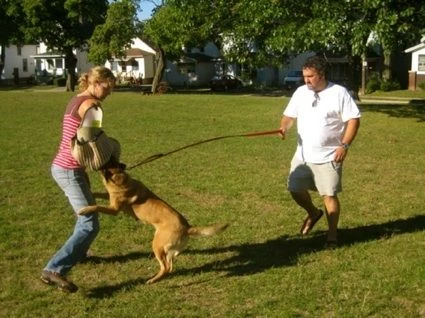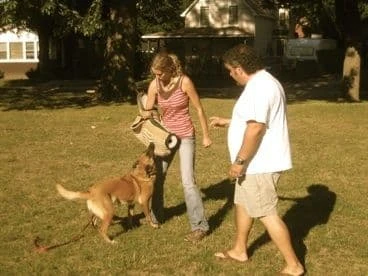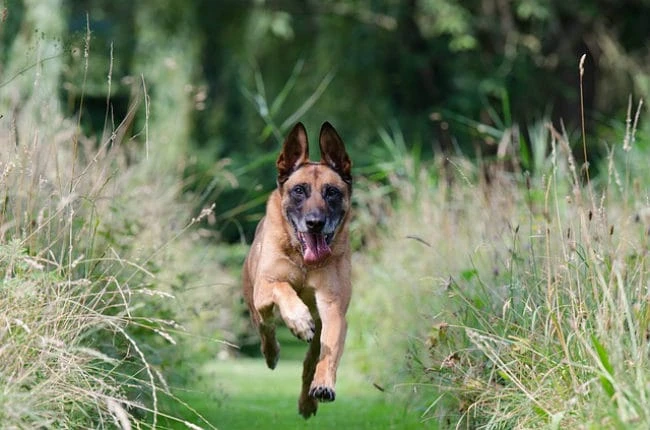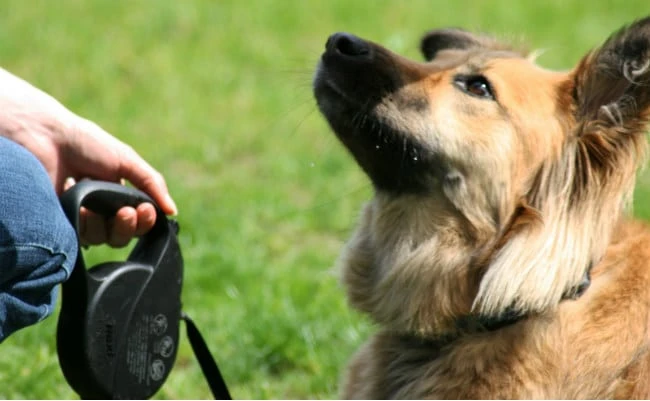Dog Training Interview, Methods to Stop Dog Barking, Crate Training & More

An Interview with top dog trainer Shannon Pennings…
 Shannon busy with Dave McMahon protection dog training.
Shannon busy with Dave McMahon protection dog training.
We are in for a treat today as we have managed to get a top dog trainer to answer some random questions.
Shannon Pennings runs Precision K9 Professional Training in Brantford, Ontario Canada (follow the link below) and is very well respected in the dog training community.
Hi Shannon firstly can we take the time to thank you for helping out our regular readers and answering some questions…so if it’s ok shall we get started right away…
Q1: Shannon in your experience is there such a thing as a bad dog – or is it a bad owner. Here in the UK there is growing concerns about the danger of some dog breeds– what are your views on this?
From my experience, I find that normally, the problem is with the owner as opposed to the dog. You can hardly blame the dog for any bad behaviors that have been caused by a fault on the side of their human, knowingly or not. Under-socializing a puppy, too much rough play as a puppy, insufficient exercise, no obedience training… all of these things and more can cause an otherwise good dog to adopt bad behaviors.
Also, some breeds were originally bred for certain tasks, and many people don’t take this into consideration when buying a new dog. Each breed has its own characteristics, and as such, not every breed will match up nicely with every family. Another point to consider is that most of the number one breeds on the highest risk of fatal dog bites are also the most popular dogs. Meaning… so many people are breeding these popular dogs (many of them not being “reputable breeders”), causing carelessness about proper bloodlines and genetics. For example, German Shepherds are one of the most popular family dogs in Canada and the U.S., but are also one of the top breeds considered dangerous for fatal bites and attacks.
So in the end, I think that it’s more a problem of not choosing an appropriate dog that will fit into your family and lifestyle as well as lack of obedience training, than a problem of bad or dangerous dog breeds.
Q2: If you could give five tips when it comes to methods to stop a dog barking what are they?
1. Find the reason for your dog’s barking – is he thirsty or hungry? Does he need to be in the shade? Is he tangled in his tie-out line or something else? Is he being territorial (barking at people through the fence, window or door)? Is he simply letting you know that someone is here? Is he in pain? Or is he bored and under-exercised and barking as an outlet for his pent up energy?
2. Any dog who is not getting sufficient exercise will display undesirable behaviors, such as nuisance barking, jumping, chewing and other destructive behavior, “hyper-activity”, digging and so on. Take your dog for a longer walk, or even better in some cases, take him biking, running or roller blading!
3. Teach your dog to be quiet on command. Have a leash and training collar on the dog, and ask a friend to go and knock on the door. When the dog starts barking, you can praise the first bark (letting you know that someone’s there), then tell him to “Quiet” in a firm tone of voice (not shouting!). If the dog continues to bark, say nothing, but loosen the leash to create an element of surprise, pop up vertically fast and firmly, and loosen the leash again. Praise when he stops barking.
4. If the sound of the doorbell is what sets your dog off, desensitize and counter-condition him to the sound of it. Ring it randomly throughout the day, and praise him for being quiet. Give a leash and collar correction if he barks at it. The goal is to make him so used to hearing the bell, that it’s not such a big deal anymore, as well as reinforcing the quiet behavior when it does ring.
5. Get an anti-bark collar. Very safe and humane, this collar should be worn for about a week without it turned on, to desensitize the dog to wearing it. Each time you put it on, you can pop a treat, praise verbally or toss his toy. Make the dog think that the collar equals good things. Feed him with it on, play with it on, walk with it on. The dog can wear this collar all day as long as they get 8 hours with no collar on at all.
Q3: What breed in your experience is easiest to train?
This question is hardly fair! Of course, every dog breed is trainable, but some dogs are able to excel much more than others. Breeds that were made for specific jobs – working breeds – are normally the quickest learners and most eager to please.
I
honestly cannot narrow it down to one specific breed as being easiest to train. It somewhat boils down to what the breed was originally bred for. A hound, which was bred to find and follow game, is not going to be as easy to train as a Belgian Malinois, who was bred to work beside humans and protect their animals.
Q4: You discuss dog behavior modification at your site – could you go into more detail and explain its methods, techniques and success rate?
Behavior modification methods and techniques usually revolve around two things – desensitizing and counter-conditioning. With a fear or separation anxiety, the goal would be to desensitize the dog to the sound or sight (thunder, cars, etc.) while at the same time changing what they thing of that object or sound (negative association into a positive association).
There is always a reason behind any given behavior, and the first step is to find this out. Doing so can often help in solving the problem. Believe it or not, many behavioral problems can be solved by simply giving a dog more exercise. Digging, nuisance barking, running away, chewing… these can all be helped by providing better outlets for the dog’s energy.
In cases of aggression, again, we first look for the reason. What’s the top reason for aggression? Under-socialization and/or a stagnant social circle. Other reasons include rough housing as a puppy, dog has been bitten or traumatized by another dog or person (manifesting itself in fear biting) or abuse. Each case is different, and there is no blanket solution. Most cases of aggression do require negative reinforcement to correct the unwanted behavior, and positive reinforcement for accepting people or dogs that he sees as a
threat.
People often think too little of socializing their dog or puppy, thinking that going for walks around the block is enough. If only they knew that most behavioral problems can be prevented by taking the time to properly socialize their dog! Puppies and all dogs should be taken to new environments and terrains (the beach, hardware store, the bank, family BBQ’s) as much as possible. I always take my dog to ball games, fairs, family functions and anywhere that my dog is allowed.
The success rate is really good with our method and techniques. And while it always depends on how much effort is put into it by the owner, almost any problem can be corrected.
Q5: What are your top tips when it comes to stopping your dog from peeing around the House?
Crate-train your dog! This is not mean or cruel – on the contrary, done properly, a dog will love his crate. My own dog, Justice, is most relaxed when she is sleeping in her crate. It’s her den, her safe place. In house-training, I always tell clients to crate the dog or puppy at night, when you go out, or whenever you can’t have your eye on them. This prevents most accidents from happening as a dog doesn’t like to lay in his urine (be sure the crate is the right size!).
Take the dog or puppy out every 45 minutes to an hour on a leash to their designated potty area. Praise immediately if they pee outside, not when you get back in the house! If there’s a puddle in the house, mop it up with a clean sponge and take it outside with the dog. Wipe it on the grass and let your dog sniff it. Be sure to clean up the spot in the house with an enzyme cleaner (not bleach!) to completely get rid of the smell, or they will pee there again.
Q6: Can you tell us the benefits that dog training classes have as opposed to training your dog yourself at home?
The most important reason why I recommend dog training group classes is for the socialization aspect. Your dog learns to obey you under distractions that simply are not around at home or in the backyard.
You can also learn from everyone else in a group setting, and it’s a lot of fun! It’s very helpful to be able to see how other dogs at the same level of obedience are progressing, and it gives your dog the opportunity to be around other well-behaved dogs.
Q7: What are your views on negative reinforcement methods? Do you agree with spray collars and even shock collars?
As a balanced trainer, I teach people to train their dogs using both positive and negative reinforcement – rewards and corrections. Training should be very black and white for a dog. All of the leash and collar corrections given are very humane, and also appropriate for each dog’s size as well as temperament.
Given firmly, humanely and with the proper timing, a correction will help the dog to understand exactly what you are asking of them as well as show them who is the leader. Coupled with a properly timed reward when they follow through with the right behavior, a dog learns very quickly to go where the advantage lies.
I completely agree with and recommend using remote training collars (sometimes called shock collars by those who do not understand them very well) for dogs in Intermediate to Advanced Level obedience training (not young, “green” dogs) and for certain behavioral issues. In the proper hands, these electronic remote collars are excellent tools for working on obedience at farther distances as well as off leash, and are the perfect tool to use for problems such as aggression or running away.
Again, I stress that people who use these tools need to be trained in their proper use. I feel that pet stores should not carry these products so that any pet owner can buy one, but that they should be purchased either through or on recommendation and with training from a certified dog trainer.
Electronic training collars (or e-collars) are very safe and humane. I recommend trying it on yourself before using it on your dog – I have done so and can say for a fact that it is not like grabbing a cow’s shock fence. The collar causes a contraction of the muscle, or a twitch.
As this issue is hugely debated among trainers around the world, it’s quite a hot topic. As far as damage or cruelty to the dog goes, I would much rather put a prong collar on a dog and teach him to heel using corrections and rewards, than have him on a flat-buckle collar and damage his throat by his constant pulling on the leash.
Just like any dog training tool, e-collars have their place not to teach a dog a new command, but to practice and proof the command once it has been taught.
Q8: What are the most important things to remember when training dogs?
Consistency. In this way like a child, a dog knows if you mean what you say. If you ever give a command and don’t follow through with it (i.e. “come”), you can bet that the next time you give that command, your dog will pull the same trick and not listen to you. Always be prepared to follow through on a command that you give.
Patience and calmness. Dogs listen to the tone of your voice, not the volume. You cannot train a dog when you are angry or frustrated. The frustration/anger will travel right down the leash and cause your dog to become anxious, agitated and unhappy about working with you. Your mood will directly affect the dog at the end of your leash!
Q9: What is the best dog food? Dry, moist, grain free, raw or should owner make their own dog food?
Personally, I like the convenience of a good quality, grain-free dry kibble. Moist or wet canned dog food tends to give a dog bad breath, and quickly builds up plaque on their teeth. The healthiest option is a quality raw diet – however, it’s not always the most convenient. But with some dogs (like mine!) having sensitive skin or allergies, the flexibility of a raw diet allows for experimentation to find a diet that does not aggravate the dog’s allergies.
That being said, there is a new dehydrated raw dog food (in a somewhat kibble form) that has all the benefits of a raw diet, with the convenience dry kibble, which is excellent.
In the end, though, you have to find what works best for your own dog by trial and error. To see if your dog is doing well on his food, look for: a soft, glossy coat and healthy-looking skin, firm stools and no flatulence.
Q10: What is your favorite dog breed and the best breed to have around children?
My favorite dog breed…. Again, I don’t have one single favorite! I love the Belgian Malinois for it’s agility, good temperament and trainability. I’m also a fan of the Dogue de Bordeaux, or French Mastiff. I love the fact that such a huge dog can be trained and all that power can be harnessed into a
wonderful companion. In general, I personally like large breeds the best.
As for which breed is the “best” for children, that’s again, not a very fair question. Any breed can be good with children, as long as they have been properly socialized as a puppy and are obedience trained. No matter what breed you go with, never leave them unattended with children. Anything can happen, even with the best dog. Large breeds can be clumsy and can easily knock over a small child, while some small breeds tend to have less patience with children (i.e. Chihuahua).
Shannon, thanks so much for taking the time out of your busy schedule and answering some of our readers questions.
If you are keen to use Shannon’s dog training services why not take a look at her site at www.precision-dog-training.com
Go from here back to our list of dog training interviews or back to dog obedience training home-page




